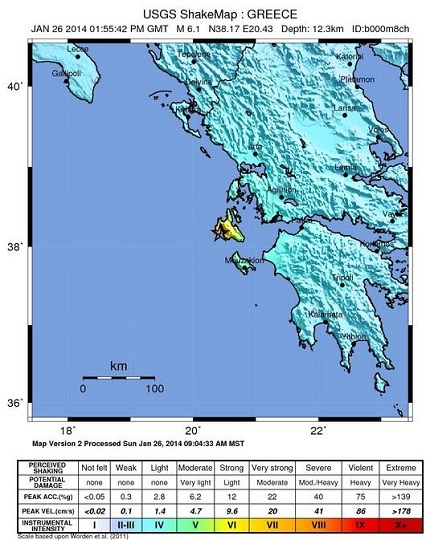Greece Earthquake
Status: Closed
| Type of posting | Posting date(EST): | Summary | Downloads |
|---|---|---|---|
| First Posting | 1/27/2014 11:00:00 AM |
|
First Posting | Summary
Posting Date: January 27, 2014, 11:00:00 AM
Moderate M6.1 Earthquake Shakes Western Greece
On Sunday, January 26, 2014, a moderate M6.1 earthquake shook the island of Kefalonia (Cephalonia) in western Greece at 3:55 p.m. (local time at the epicenter, corresponding to 1:55 p.m. UTC). Ground shaking was felt across Greece, including in Athens, located about 289 kilometers (180 miles) east of the epicenter. The earthquake was also felt in several nearby countries, including Albania, Montenegro, Bulgaria, and southern Italy. As of January 27, the majority of the known damage has been confined to broken windows, cracked roadways, and landslides; however, older masonry buildings near the epicenter have reportedly collapsed. The main shock has, so far, been followed by 12 aftershocks, including three notable aftershocks (M4.4, M4.2, and M5.2).
Reported Damage and Disruption
Most buildings have withstood the ground shaking inflicted by the M6.1 event with only minor damage, such as cracked windows, broken walls, and fallen bricks. Cracks also appeared in the seawall in Lixourion (close to the epicenter). However, older buildings of unreinforced masonry near the epicenter have reportedly collapsed. Specifically, in Lixourion, a hospice and some homes were completely destroyed. A state of emergency has been declared on the island, and local schools have been closed pending detailed examination of the damage sustained from the earthquake.
According to local reports, power outages in Kefalonia followed the event, although electricity has since been restored to parts of the island. Rockfalls and landslides have damaged roadways in mountainous regions, particularly in the northern part of the island, where some roads are blocked by landslides.
Local authorities have cautioned residents not to stay in damaged homes. Passenger ferries that can accommodate hundreds of passengers have been dispatched to the island to provide housing for displaced residents.
Regional Seismicity
The eastern Mediterranean is a region of high seismic activity due to the interactions of three major tectonic plates – the Eurasia, Africa, and Arabia plates – as well as the relatively small Aegean Sea plate that bisects Greece. Seismic activity results from the northward convergence of the African plate with respect to the Eurasian plate along a complex plate boundary. In central and northern Greece, most earthquakes result from interaction between the Eurasia plate and the much smaller Aegean Sea plate; most of these earthquakes involve normal faulting. In southern and western Greece, seismotectonics are largely governed by the motion of the Africa plate with respect to the Aegean Sea plate, which results in locally high rates of convergence (35 mm/yr) in the Hellenic subduction zone of southern Greece. Most earthquakes that occur in this zone are reverse or strike-slip events, although some normal faulting events have been noted. Several major faults are located in Greece as a consequence of these tectonic forces, including the Cephalonia Transform Fault.
The January 26 earthquake exhibited a strike-slip deformation style, and occurred at a relatively shallow focal depth of 12.4 kilometers (7.7 miles). Ground shaking of MMI VIII intensity (Modified Mercalli Intensity Scale, MMI) was reported near the epicenter, while weaker ground shaking was felt across Greece and in other countries such as Italy, Albania, Montenegro, and Bulgaria. The fault that produced this event is still uncertain. Preliminary reports stated that the event was produced by the same fault that caused the devastating August 12, 1953, M7.3 earthquake, whose epicenter was approximately 15 kilometers east of yesterday’s event. However, local scientists maintain that the fault causing Sunday’s earthquake has not yet been identified.
Exposure at Risk
Construction in Greece is dominated by reinforced concrete frame buildings and one- or two- story unreinforced masonry buildings. In load-bearing stone masonry wall construction, the walls are made of local field stones and lime mortar, with timber floors and roofs. The seismic performance of these structures is generally poor. In recent years, multi-story reinforced concrete (RC) buildings have become more common throughout Greece, representing about 30% of the country’s building stock. The main lateral load resisting system in most of these structures is the RC frame; however, some exhibit shear walls. The seismic performance of these buildings is generally good, provided that a soft story is not present. Failure due to a soft ground floor was common in past earthquakes, such as the 1999 Athens earthquake.
While most buildings are constructed to older seismic design codes in Greece, the latest seismic codes consider Kefalonia Island as a seismic region and thus require adequate seismic design. If built appropriately to the latest codes, newly constructed buildings are expected to perform well.
Early intensity reports show a maximum intensity of MMI VIII around the epicenter, but generally lower intensities in areas with a higher concentration of population and exposure. At intensity levels around the epicenter (MMI VIII), slight damage to well-designed structures is expected; however, considerable damage to ordinary buildings, and serious damage — including partial collapse — of poorly built structures is expected. Fallen chimneys, factory stacks, columns, monuments, and walls are also expected. Damage to contents and furniture may also be anticipated.
AIR continues to monitor the situation and will provide updates if warranted by events.
